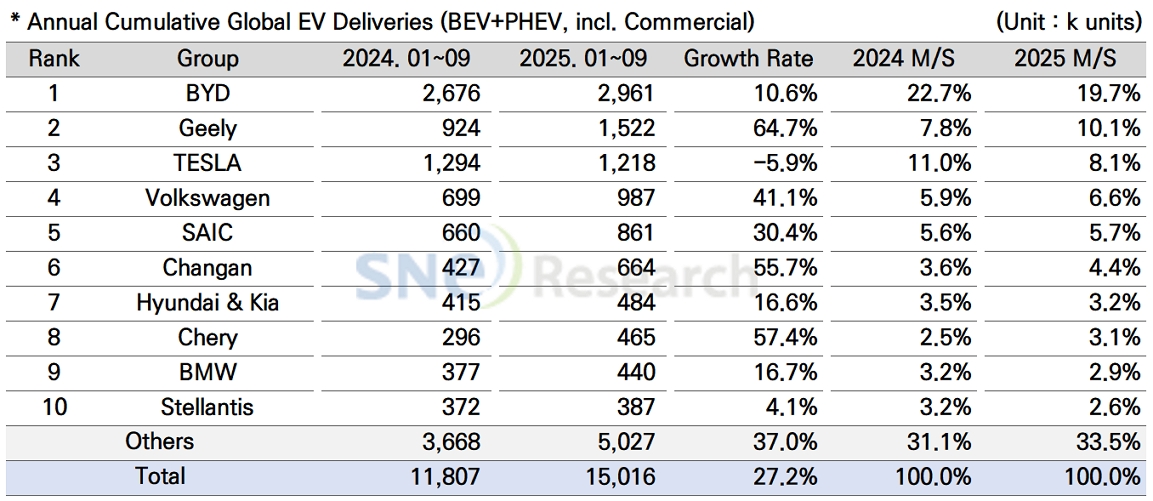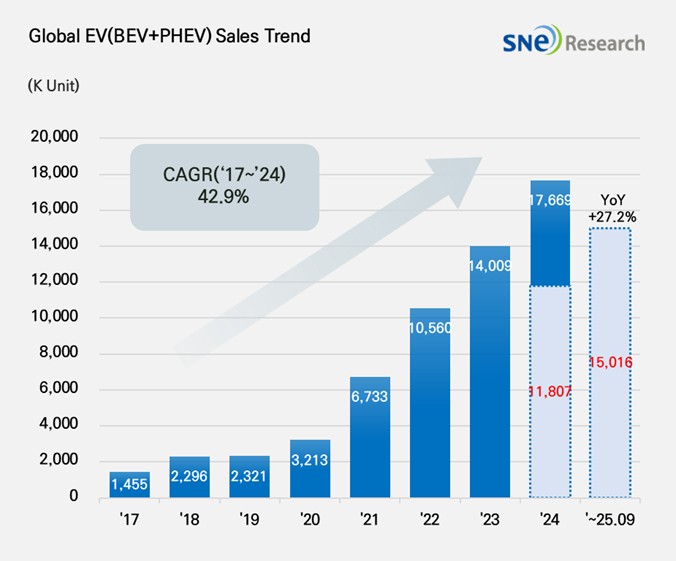From Jan to Sep in 2025, Global[1] Electric Vehicle Deliveries[2] Recorded Approximately 15.016Mil Units, a 27.2% YoY Growth
-
BYD
remained top by selling 2.961 mil units; Geely ranked 2nd with 64.7%
growth
From Jan to Sep in 2025, the number of
electric vehicles registered in countries around the world was approximately 15.016
million units, a 27.2% increase from the same period last year (11.807 mil
units).
(Source: Global EV and Battery Monthly Tracker – Oct 2025, SNE Research)
From Jan to Sep in 2025, BYD remained top in the global ranking by selling approx. 2.961 million units, recording a 10.6% YoY growth. BYD has been flexibly responding to recent changes in tariffs and subsidy policies by building production sites in the European region (Hungary and Turkey) and the Southeastern Asian region (Thailand, Indonesia, and Cambodia). While steadily increasing its brand awareness based on price competitiveness and technology, BYD has been working to diversify its model line-ups from commercial vehicles to ultra-small vehicles to improve its competitiveness across the entire ecosystem for electric vehicles. BYD has lowered its annual sales goal from 5.50 million units to 4.60 million units, which is equivalent to around 7% YoY growth. The major background for this seems to be intensified competition among the Chinese OEMs in the electric vehicle market.
Geely Group in the 2nd place continued to see double-digit growth by selling approx. 1.522 million units and posting a 64.7YoY growth. Geely’s Star Wish(星愿) model is gaining popularity and contributing to expansion of line-ups. Its premium brand ZEEKR(极氪), hybrid-dedicated Galaxy(银河), and LYNK & CO(领克), aiming for the global market, are absorbing demands based on its multilayered brand portfolio. Geely Group has been very responsive in converting from internal combustion engine vehicles to electric vehicles. The group also accelerated the in-house development of technology for batteries, electrical equipment, and software as well as the increase of production capacities. These vertical integration and in-house technology development strategies have been evaluated as key drives behind the competitiveness of Geely.
Tesla ranked 3rd in terms of global EV sales by selling 1.218 million units and posting a 5.9% YoY decrease. A slowdown in sales of Model 3 and Y has made the entire sales drop, and particularly, Model 3 and Y saw a 4.3% decrease in global sales (1.232 million units → 1.179 million units), adding more pressure on Tesla to perform better in the market. By region, Tesla saw a 19.7% YoY decline in sales in the European market (198k units) and a 6.0% YoY decrease in the Chinese market (433k units). On the other hand, in the North American market, Tesla posted a 2.3% YoY increase (434k units) in sales due to the termination of tax credit benefits offered to customers. Although Tesla continued to implement strategies to sophisticate FSD function and expand the monthly subscription-based software profit model, it seems Tesla would only see limited effects in noticeably improving sales in the short term.

(Source: Global EV and Battery Monthly Tracker – Oct 2025, SNE Research)
Hyundai Motor Group sold approx. 484k units of electric vehicles, recording a 16.6% YoY increase and showing a steady growth in the global EV market. In terms of BEV, IONIQ 5 and EV 3 were leading the growth of sales, while small-sized, strategic models such as Casper (Inster) EV, EV 5, and Creta Electric received positive feedback from the market. On the other hand, some of the existing models such as EV 6, EV 9, and Kona Electric showed a slowdown in sales, failing to maintain their growth momentum. Hyundai delivered a total of 83k units of PHEVs, with Sportage, Tucson, and Sorento maintaining a steady trend of sales, while Niro and Seed experienced a visible slowdown in sales. Hyundai delivered 64k units in the North American market, ranking 3rd in the market and following Tesla and GM. Despite posting 8.7% YoY decline, Hyundai Motor Group still outperformed its major competitors such as Ford, Stellantis, Toyota, and Volkswagen, which is very meaningful to the group. With the expanded sales of EV 3 in the global market, Hyundai has been diversifying its electrification portfolio by adding new line-ups such as EV 4 and IONIQ 9. Through its strategies to expand the proportion of local procurement and optimize the product line-ups by region, the group is expected to maintain stability in profit structure even amidst current issues related to fluctuating subsidies and tariffs.

(Source: Global EV and Battery Monthly Tracker – Oct 2025, SNE Research)
From January to September 2025, the global electric vehicle (EV) market has shown divergent trends across regions, with growth patterns varying significantly depending on each country’s policy environment and demand structure.
In China, accounting for the biggest market share of 63% or higher in the global market, a total of 9.471 million units of electric vehicles were sold, recording a 26.7% YoY increase. Although the growth of Chinese domestic market has slowed down, demand for mid-to-low price, entry-level electric vehicles has continued, and the electrification of commercial vehicles maintained. In particular, major OEMs such as BYD, Geely, and SAIC have been expanding export to overseas markets including Europe and Central and South America while reducing their dependence on domestic demand in the China market. Battery manufacturers such as CATL and EVE Energy are not only leveraging the cost competitiveness of LFP technology but are also accelerating the commercialization of next-generation chemistries like LMFP and sodium-ion batteries to achieve both cost reduction and higher energy density. This diversification of technology and export strategies indicates that the growth axis of China’s EV industry is shifting from domestic demand to a globally oriented supply-driven model.
In Europe, a total of 2.981 million units of electric vehicles were sold, posting a 32.2% YoY growth and taking up 19.9% of market share. Recently, the growth of European EV market was led by mid-size SUVs and crossover vehicles such as ID.4, Q4 e-Tron, EV 3, EX 30, and iX1. These models, designed for practical family-oriented demand, combine high efficiency and affordable pricing while leveraging universal electrification platforms such as MEB and PPE, driving rapid market expansion. Moreover, major OEMs including Volkswagen, Volvo, BMW, and Mercedes-Benz are strengthening platform integration strategies to improve production efficiency and simplify their model lineups. This trend is emerging as a key factor reshaping the European EV market structure, shifting its focus toward mid-sized vehicles.
In the North American market, a total of 1.443 million units of electric vehicles were sold, recording a 9.0% YoY growth. The market share of North American market has slightly dropped to 9.6%. At the end of September, the expiration of consumer tax credits under the Inflation Reduction Act (IRA) led major OEMs to launch aggressive promotions aimed at clearing inventory and boosting sales, resulting in a short-term surge in EV deliveries. However, with the expiration of tax credit benefits, a slowdown in demand appears inevitable. GM, Ford, and Hyundai Motor Group are adjusting their strategies by reshaping their lineups around mid- to low-priced segments and expanding hybrid models. In the North American market, short-term volatility is increasing due to changes in tax policy, while local production share and price competitiveness are emerging as the key factors determining future market share.
The Asia market (excluding China) exhibited a 50.4% YoY growth with 834k units of electric vehicles sold, accounting for 5.6% of the global market share. In India, the adoption of small electric vehicles priced between USD 10,000 and 20,000 is expanding rapidly, with Tata Motors and Mahindra leading market growth. In Thailand and Indonesia, Chinese OEMs such as BYD, SAIC, and Chery have begun full-scale operation of local plants, strengthening these countries’ positions as regional production hubs. In contrast, global OEMs are responding by focusing on localized pricing strategies and model customization tailored to local demand structures, prioritizing market adaptability over the speed of electrification. In Japan, Toyota and Honda continue to pursue hybrid-centered strategies while gradually expanding their BEV lineups. Amid these developments, non-Chinese Asian markets are entering a multi-layered growth phase, characterized by the expansion of real demand for affordable models and the coexistence of regionally differentiated strategies.
In 2025, the global electric vehicle (EV) market continues to grow, but regional differences in demand structures and policy environments have become increasingly pronounced. In China, growth is being driven by domestic demand for mid- to low-priced models alongside the electrification of commercial vehicles. In Europe, despite moderate sales growth supported by new model launches and price competition, high interest rates and weak consumer sentiment are slowing the pace of recovery. In North America, concerns about a post–tax credit demand slowdown are emerging, prompting major automakers to accelerate a shift toward hybrid-focused strategies. Meanwhile, emerging Asian markets are expanding their EV bases through affordable models and increased local production. Amid these developments, global automakers are striving to secure long-term competitiveness despite policy uncertainty and profitability pressures, focusing on technology localization, strengthening local supply chains, and cost-efficient product strategies.
[2] Based on electric vehicles (BEV+PHEV) delivered to customers or registered during the relevant period


